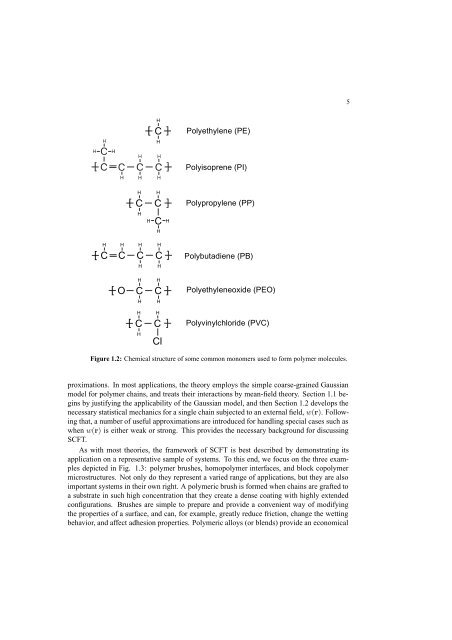Self-Consistent Field Theory and Its Applications by M. W. Matsen
Self-Consistent Field Theory and Its Applications by M. W. Matsen
Self-Consistent Field Theory and Its Applications by M. W. Matsen
Create successful ePaper yourself
Turn your PDF publications into a flip-book with our unique Google optimized e-Paper software.
5<br />
[<br />
H<br />
C<br />
H<br />
Polyethylene (PE)<br />
Polyisoprene (PI)<br />
[<br />
H<br />
C<br />
H<br />
H<br />
H<br />
C<br />
C H<br />
H<br />
Polypropylene (PP)<br />
H<br />
[ C<br />
H<br />
C<br />
H<br />
C<br />
H<br />
H<br />
C<br />
H<br />
Polybutadiene (PB)<br />
H<br />
H<br />
[ O C C Polyethyleneoxide (PEO)<br />
H H<br />
H<br />
C<br />
H<br />
H<br />
[ Polyvinylchloride (PVC)<br />
C<br />
Cl<br />
Figure 1.2: Chemical structure of some common monomers used to form polymer molecules.<br />
proximations. In most applications, the theory employs the simple coarse-grained Gaussian<br />
model for polymer chains, <strong>and</strong> treats their interactions <strong>by</strong> mean-field theory. Section 1.1 begins<br />
<strong>by</strong> justifying the applicability of the Gaussian model, <strong>and</strong> then Section 1.2 develops the<br />
necessary statistical mechanics for a single chain subjected to an external field, w(r). Following<br />
that, a number of useful approximations are introduced for h<strong>and</strong>ling special cases such as<br />
when w(r) is either weak or strong. This provides the necessary background for discussing<br />
SCFT.<br />
As with most theories, the framework of SCFT is best described <strong>by</strong> demonstrating its<br />
application on a representative sample of systems. To this end, we focus on the three examples<br />
depicted in Fig. 1.3: polymer brushes, homopolymer interfaces, <strong>and</strong> block copolymer<br />
microstructures. Not only do they represent a varied range of applications, but they are also<br />
important systems in their own right. A polymeric brush is formed when chains are grafted to<br />
a substrate in such high concentration that they create a dense coating with highly extended<br />
configurations. Brushes are simple to prepare <strong>and</strong> provide a convenient way of modifying<br />
the properties of a surface, <strong>and</strong> can, for example, greatly reduce friction, change the wetting<br />
behavior, <strong>and</strong> affect adhesion properties. Polymeric alloys (or blends) provide an economical
















